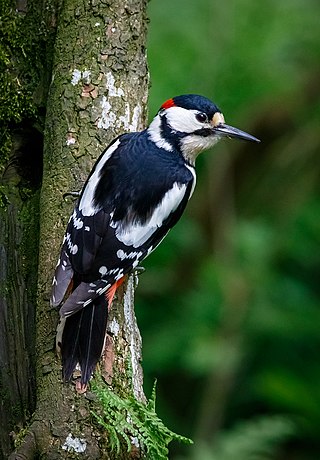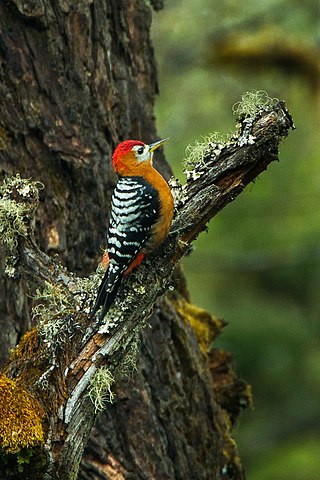
The great spotted woodpecker is a medium-sized woodpecker with pied black and white plumage and a red patch on the lower belly. Males and young birds also have red markings on the neck or head. This species is found across the Palearctic including parts of North Africa. Across most of its range it is resident, but in the north some will migrate if the conifer cone crop fails. Some individuals have a tendency to wander, leading to the recent recolonisation of Ireland and to vagrancy to North America. Great spotted woodpeckers chisel into trees to find food or excavate nest holes, and also drum for contact and territorial advertisement; like other woodpeckers, they have anatomical adaptations to manage the physical stresses from the hammering action. This species is similar to the Syrian woodpecker.

The lesser spotted woodpecker is a member of the woodpecker family Picidae. It was formerly assigned to the genus Dendrocopos. Some taxonomic authorities continue to list the species there.

The European green woodpecker is a large green woodpecker with a bright red crown and a black moustache. Males have a red centre to the moustache stripe which is absent in females. It is resident across much of Europe and the western Palearctic but in Spain and Portugal it is replaced by the similar Iberian green woodpecker.

Woodpeckers are part of the bird family Picidae, which also includes the piculets, wrynecks, and sapsuckers. Members of this family are found worldwide, except for Australia, New Guinea, New Zealand, Madagascar, and the extreme polar regions. Most species live in forests or woodland habitats, although a few species are known that live in treeless areas, such as rocky hillsides and deserts, and the Gila woodpecker specialises in exploiting cacti.

The red-bellied woodpecker is a medium-sized woodpecker of the family Picidae. It breeds mainly in the eastern United States, ranging as far south as Florida and as far north as Canada. Though it has a vivid orange-red crown and nape it is not to be confused with the red-headed woodpecker, a separate species of woodpecker in the same genus with an entirely red head and neck that sports a solid black back and white belly. The red-bellied earns its name from the pale reddish blush of its lower underside.

The middle spotted woodpecker is a European woodpecker belonging to the genus Dendrocoptes.

The white-backed woodpecker is a Eurasian woodpecker belonging to the genus Dendrocopos.

Levaillant's woodpecker or Levaillant's green woodpecker, is a large African member of the woodpecker family Picidae.

The striped woodpecker is a species of bird in subfamily Picinae of the woodpecker family Picidae. It is found in Argentina, Bolivia, and Chile.
The Arabian woodpecker or Sarat woodpecker, is a bird species of the family Picidae, native to the Sarawat Mountains of Saudi Arabia and Yemen. It is the only woodpecker that breeds on the Arabian Peninsula.

The Japanese pygmy woodpecker or pygmy woodpecker is a species of woodpecker. It is found in coniferous and deciduous forests in Russia, China, Korea and Japan. This species has also been placed in the genus Dendrocopos or Picoides. The International Union for Conservation of Nature (IUCN) has assessed it as a least-concern species.

The Hispaniolan woodpecker is a medium-sized woodpecker endemic to the Caribbean island of Hispaniola.

The Knysna woodpecker is a species of bird in the family Picidae. It is endemic to South Africa, where its natural habitats are subtropical or tropical moist lowland forests, moist savanna, and subtropical or tropical moist shrubland. It is threatened by habitat loss. It belongs to a species complex that includes the golden-tailed and Mombasa woodpeckers.

The stripe-breasted woodpecker is a species of bird in the woodpecker family, Picidae. It is found in Southeast Asia within subtropical or tropical moist lowland forest and subtropical or tropical moist montane forest.

The crimson-breasted woodpecker or scarlet-breasted woodpecker is a species of bird in the family Picidae. It is found in Bangladesh, Bhutan, China, India, Laos, Myanmar, Nepal, Thailand, and Vietnam. Its natural habitats are subtropical or tropical moist lowland forests and subtropical or tropical moist montane forests. Some taxonomic authorities continue to place this species in the genus Dendrocopos. The scarlet-breasted woodpecker, is considered to be distinct by some authorities, but others consider it to be conspecific.

The Darjeeling woodpecker is a species of bird in the family Picidae. It is found in the northern regions of the Indian subcontinent, primarily in the Himalayas, and in some adjoining areas.

The Himalayan woodpecker is a species of bird in the family Picidae. It is found in the northern regions of the Indian subcontinent, primarily the Himalayas and some adjoining areas, and ranges across Afghanistan, India, Nepal, Bhutan and Pakistan. Its natural habitats are boreal forests and temperate forests. The International Union for Conservation of Nature has assessed its conservation status as being of "least concern".

The rufous-bellied woodpecker or rufous-bellied sapsucker is a species of bird in the family Picidae. This woodpecker has a habit of making a series of small pits on the bark of trees leading to its being considered an Asiatic member of the sapsuckers in the past. It is found along the Himalayas in the Indian subcontinent and Southeast Asia, ranging across Bangladesh, Bhutan, Cambodia, Hong Kong, India, Korea, Myanmar, Nepal, Thailand, Manchuria, Ussuriland and Vietnam. Its natural habitats are subtropical or tropical moist lowland forests and subtropical or tropical moist montane forests.

The ashy woodpecker is a species of bird in the woodpecker family Picidae. It is endemic to Sulawesi and surrounding islands in Indonesia. There are two subspecies, the nominate race M. f. fulvus, which is found in northern Sulawesi, the islands of Lembeh and Manterawu, and the archipelagos of Togian and Banggai; and M. f. wallacei, from southern Sulawesi and the islands of Muna and Buton. The second subspecies is named for the collector and scientist Alfred Russel Wallace.

The Red-backed flameback, Lesser Sri Lanka flameback, Sri Lanka red-backed woodpecker or Ceylon red-backed woodpecker is a species of bird in the family Picidae. It is endemic to Sri Lanka, only absent in the far-north. It is sometimes considered a subspecies of the Black-rumped flameback.























